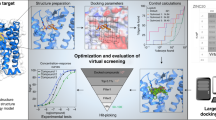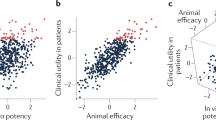Abstract
Lack of success with early combinatorial chemistry and high-throughput screening approaches resulted from inappropriate compound selection. We are now aware that screening compounds should be either 'lead-like' or 'drug-like' and have the potential to be orally available. However, there is a growing tendency to misuse such terms and to overestimate their importance, and to overemphasize ADME problems in clinical failure. Sometimes, this goes hand-in-hand with an uncritical application of high-throughput in silico methods. Structure-based and computer-aided approaches can only be as good as the medicinal chemistry they are based on. The search for new drugs, especially in lead optimization, is an evolutionary process that is only likely to be successful if new methods merge with classical medicinal chemistry knowledge.
This is a preview of subscription content, access via your institution
Access options
Subscribe to this journal
Receive 12 print issues and online access
$209.00 per year
only $17.42 per issue
Buy this article
- Purchase on Springer Link
- Instant access to full article PDF
Prices may be subject to local taxes which are calculated during checkout

Similar content being viewed by others
References
Horrobin, D. F. Modern biomedical research: an internally self-consistent universe with little contact with medical reality? Nature Rev. Drug Discov. 2, 151–154 (2003).
Drews, J. Strategic trends in the drug industry. Drug Discov. Today 8, 411–420 (2003).
Hopkins, A. L. & Groom, C. R. The druggable genome. Nature Rev. Drug Discov. 1, 727–730 (2002).
Lahana, R. How many leads from HTS? Drug Discov. Today 4, 447–448 (1999).
Lipinski, C. A., Lombardo F., Dominy, B. W. & Feeney, P. J. Experimental and computational approaches to estimate solubility and permeability in drug discovery and development settings. Adv. Drug Del. Rev. 23, 3–25 (1997).
Ertl, P., Rohde, B. & Selzer, P. Fast calculation of molecular polar surface area as a sum of fragment-based contributions and its application to the prediction of drug transport properties. J. Med. Chem. 43, 3714–3717 (2000).
Cruciani, G., Pastor, M. & Guba, W. VolSurf: a new tool for the pharmacokinetic optimization of lead compounds. Eur. J. Pharm. Sci. 11 (Suppl. 2) S29–S39 (2000).
Kelder, J., Grootenhuis, P. D., Bayada, D. M., Delbressine, L. P. & Ploemen, J. P. Polar molecular surface as a dominating determinant for oral absorption and brain penetration of drugs. Pharm. Res. 16, 1514–1519 (1999).
Bergström, C. A. S. et al. Absorption classification of oral drugs based on molecular surface properties. J. Med. Chem. 46, 558–570 (2003).
Veber, D. F. et al. Molecular properties that influence the oral bioavailability of drug candidates. J. Med. Chem. 45, 2615–2623 (2002).
Wenlock, M. C., Austin, R. P., Barton, P., Davis, A. M. & Leeson, P. D. A comparison of physicochemical property profiles of development and marketed oral drugs. J. Med. Chem. 46, 1250–1256 (2003).
Prentis, R. A., Lis, Y. & Walker, S. R. Pharmaceutical innovation by the seven UK-owned pharmaceutical companies (1964–1985). Br. J. Clin. Pharmacol. 25, 387–396 (1988).
Kennedy, T. Managing the drug discovery/development interface. Drug Discov. Today 2, 436–444 (1997).
van de Waterbeemd, H. & Gifford, E. ADMET in silico modelling: towards prediction paradise? Nature Rev. Drug Discov. 2, 192–204 (2003).
Lipinski, C. A. Drug-like properties and the causes of poor solubility and poor permeability. J. Pharmacol. Toxicol. Methods 44, 235–249 (2000).
Ajay, A., Walters, W. P. & Murcko, M. A. Can we learn to distinguish between 'drug-like' and 'nondrug-like' molecules? J. Med. Chem. 41, 3314–3324 (1998).
Sadowski, J. & Kubinyi, H. A scoring scheme for discriminating between drugs and nondrugs. J. Med. Chem. 41, 3325–3329 (1998).
Teague, S. J., Davis, A. M., Leeson, P. D. & Oprea, T. The design of leadlike combinatorial libraries. Angew. Chem. Int. Ed. 38, 3743–3748 (1999).
Oprea, T. I., Davis, A. M., Teague, S. J. & Leeson, P. D. Is there a difference between leads and drugs? A historical perspective. J. Chem. Inf. Comput. Sci. 41, 1308–1316 (2001).
Proudfoot, J. R. Drugs, leads, and drug-likeness: an analysis of some recently launched drugs. Bioorg. Med. Chem. Lett. 12, 1647–1650 (2002).
Hann, M. M., Leach, A. R. & Harper, G. Molecular complexity and its impact on the probability of finding leads for drug discovery. J. Chem. Inf. Comput. Sci. 41, 856–864 (2001).
Carr, R. & Hann, M. The right road to drug discovery? Fragment-based screening casts doubt on the Lipinski route. Modern Drug Discov. April, 45–48 (2002)
Lommerse, J. P. M., Price, S. L. & Taylor, R. Hydrogen bonding of carbonyl, ether, and ester oxygen atoms with alkanol hydroxyl groups. J. Comput. Chem. 18, 757–774 (1997).
Böhm, H. -J., Brode, S., Hesse, U. & Klebe, G. Oxygen and nitrogen in competitive situations: which is the hydrogen-bond acceptor? Chem. Eur. J. 2, 1509–1513 (1996).
Kubinyi, H. in Pharmacokinetic Optimization in Drug Research: Biological, Physicochemical, and Computational Strategies (eds Testa, B., van de Waterbeemd, H., Folkers, G. & Guy, R.) 513–524 (Helvetica Chimica Acta and Wiley-VCH, Zurich, 2001).
Sneader, W. Drug Prototypes and Their Exploitation. (John Wiley & Sons, Chichester, 1996).
Wermuth, C. G. The Practice of Medicinal Chemistry. (Academic, London, 1996).
Watson, J. D. The Double Helix: A Personal Account of the Discovery of the Structure of DNA. (Atheneum, New York, 1968).
Watson, J. D., with Berry, A. DNA. The Secret of Life. (William Heinemann, London, 2003).
Finding the flaws [online] (cited May 2003) <http://www.phy.cam.ac.uk/camphy/dna/dna13_1.htm> (2003).
A working model! [online] (cited May 2003) <http://www.phy.cam.ac.uk/camphy/dna/dna14_1.htm> (2003).
Author information
Authors and Affiliations
Related links
Rights and permissions
About this article
Cite this article
Kubinyi, H. Drug research: myths, hype and reality. Nat Rev Drug Discov 2, 665–668 (2003). https://doi.org/10.1038/nrd1156
Issue Date:
DOI: https://doi.org/10.1038/nrd1156
This article is cited by
-
On the Hyping of Scholarly Research (with a Shout-Out to ChatGPT)
Postdigital Science and Education (2023)
-
The multiple meanings of translational research in (bio)medical research
History and Philosophy of the Life Sciences (2019)
-
In vitro antiplasmodial activity, pharmacokinetic profiles and interference in isoprenoid pathway of 2-aniline-3-hydroxy-1.4-naphthoquinone derivatives
Malaria Journal (2018)
-
Unexplored therapeutic opportunities in the human genome
Nature Reviews Drug Discovery (2018)
-
Dynamic ligand-based pharmacophore modeling and virtual screening to identify mycobacterial cyclopropane synthase inhibitors
Journal of Chemical Sciences (2016)



